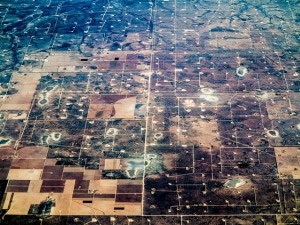 Alex Pietrowski
Alex Pietrowski
Activist Post
The movement against hydraulic gas fracturing, or ‘fracking,’ is becoming mainstream as this toxic and rapidly expanding technique by the oil and gas industry affects more and more everyday people.
Essentially, fracking is the process of forcefully injecting different blends of chemicals, fresh water, gasses, sands or other materials underground into geologic layers of rock or coal formations, which then causes the underground formations to fracture, crack or break up, resulting in the recoverable release of oil and gas.
The process has gained tremendous popularity in recent years because when coupled with other horizontal drilling techniques it has allowed access to tremendous deposits of oil and natural gas that were previously unavailable with other conventional extraction methods. Fracking has created a new energy boom here in the US, the UK, and in many other countries worldwide, although some analysts predict it won’t last long.
It may be profitable for some in the short term, but there are serious and growing concerns about the long-term effects this is having on the environment and on the health of communities near fracturing wells. The major, recognized adverse affects of fracking already include:
- High Levels of Water Use
- High Usage of Sand and Proppants
- Use of Toxic Proprietary Chemical Fracking Fluids
- Contamination of Surface Water and Soil
- Contamination of Groundwater
- Air Quality and Pollution
- Disposal of Wastewater and Other Waste Chemicals
- Release of Radioactive Materials From Underground
Although the oil and gas industry simply will not admit it, another shocking side effect of hydraulic gas fracturing is the creation of of earthquakes in areas where earthquakes had previously been rare or non-existent. In addiction to the anecdotal evidence of residents in highly fracked areas, The United States Geological Survey has also recently reported on the dramatic increase of earthquakes in just the Eastern United States, and has linked this rise to fracking:
The number of earthquakes has increased dramatically over the past few years within the central and eastern United States. Nearly 450 earthquakes magnitude 3.0 and larger occurred in the four years from 2010-2013, over 100 per year on average, compared with an average rate of 20 earthquakes per year observed from 1970-2000.
USGS scientists have found that at some locations the increase in seismicity coincides with the injection of wastewater in deep disposal wells. Much of this wastewater is a byproduct of oil and gas production and is routinely disposed of by injection into wells specifically designed for this purpose. [Source]
Calling this, ‘Induced Seismicity,’ geologists explain how the actual process of fracking may not be the direct source of the increased seismic activity, but rather the creation and usage of ‘disposal wells’ deep below the earth’s surface, where the toxic byproducts of the practice are dumped, is what is causing these massive upticks in earthquakes. Either way, the dumping of fracking waste fluids in ‘disposal wells’ is an integral part of the overall process of most forms of hydraulic fracturing; and although the oil and gas industry use this semantic point to claim that fracking does not cause earthquakes, the new reality for many US states is that earthquakes are a new feature of the environment, and appear to be here to stay.
 Earthquakes, either geologically attributed to fracking or circumstantially linked to fracking are being reported in at least the following 6 states already, and as this practice continues we are sure to see this list grow
Earthquakes, either geologically attributed to fracking or circumstantially linked to fracking are being reported in at least the following 6 states already, and as this practice continues we are sure to see this list grow
- Texas
- Oklahoma
- Arkansas
- Ohio
- Kansas
- Colorado
Fracking for the Future
As the industry accelerates fracking in the US and globally, the banking industry is also pushing fracking as a prime investment for savvy brokers and traders. This spells disaster for many communities and natural habitats as the environmental impacts continue to mount as well. Some proponents argue that using the method of gas injection instead of fracking fluids is a better approach, because it does not require the creation of ‘disposal wells’ yet this process has its unique associated environmental problems.
While it may bring short-term profits to some, along with the arguable prospect of creating jobs and boosting the economy, the long-term effects to community, to society and to the environment far outweigh the perceived economic benefits. Additionally, much of the oil and gas captured by fracking operations in the US is sold and exported to international markets, meaning that this process doesn’t directly contribute to the alleviation of our energy needs at home; however, we certainly do get stuck with the high environmental costs.
The massive proliferation of fracking is meeting increasing opposition by many levels of society, and as time goes by and the number of fracking wells increases, it is certain that Americans en masse will come to regret allowing the government to go along with the oil and gas industry to do this.
Resources:
- http://www.earthworksaction.org/issues/detail/hydraulic_fracturing_101
- http://energywithjr.quora.com/The-History-of-Fracking-A-Timeline
- http://energy.usgs.gov/OilGas/UnconventionalOilGas/HydraulicFracturing.aspx
- http://www.wakingtimes.com/2014/02/25/earthquakes-rattle-texas-towns-barnett-shale/
- http://www.wakingtimes.com/2013/09/06/fracking-away-water-supply/
- http://www.bloomberg.com/news/2012-04-20/fracking-linked-earthquakes-spurring-state-regulations.html
- http://www.motherjones.com/environment/2013/03/does-fracking-cause-earthquakes-wastewater-dewatering
- https://www.youtube.com/watch?v=LhIPMTTyEVI
- https://www.youtube.com/watch?v=k3ztoZL021U
- https://www.youtube.com/watch?v=NSUFwy2NnFA
- http://www.denverpost.com/ci_22118583/colo-officials-question-link-fracking-waste-disposal-quakes
- http://www.kansas.com/2014/02/17/3294789/gov-sam-brownback-appoints-panel.html
- http://www.bloomberg.com/news/2013-12-11/fracking-boom-pushes-u-s-oil-output-to-25-year-high.html
Related Activist Post Article:
New Study Suggests Disturbing Link Between Fracking and Large Earthquakes
Alex Pietrowski is an artist and writer concerned with preserving good health and the basic freedom to enjoy a healthy lifestyle. He is a staff writer for WakingTimes.com and an avid student of Yoga and life.


Be the first to comment on "6 States Where Fracking Earthquakes are a New Feature of Reality"